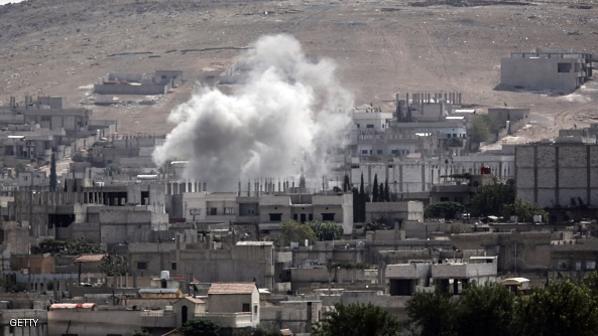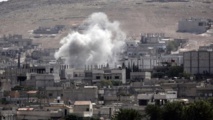The number of daily air strikes near the northern town has jumped from a handful to up to five on Tuesday and 28 on Wednesday, according to Central Command, which runs the air war.
"We get them when we see them," said one military officer, who spoke on condition of anonymity.
"Opportunities (for air strikes) are presenting themselves in Kobane right now," the officer told AFP.
But officials insisted there were no forward air controllers on the ground directing the strikes or a decision to ramp up the bombing runs.
Some military analysts speculated that the Americans may have directed more surveillance aircraft to the Kobane area, enabling them to pick out more potential targets. But US officials declined to comment on that possibility.
There is "no change in strategy but ISIL (IS) has exposed their forces as they have pushed north to Kobane and provided solid targets," said another senior military official, who asked not to be named.
US commanders were mindful of the dire humanitarian situation for the Kurds in Kobane but Washington did not consider it a strategic location, the official said.
"We're not going to be drawn into a town-by-town strategy," the official said.
For US commanders, the top priority was defeating the IS group first in neighboring Iraq, where there were more capable local forces to work with, he said.
But in Syria, the objective was to merely to disrupt the IS group's supply lines and sanctuaries, as there was no viable, moderate rebel force on the ground conducting offensives, the official said.
Central Command said bomber aircraft struck jihadist forces south and north of Kobane on Thursday, destroying a tank, a heavy machine gun and four IS-held buildings. Five air raids earlier on Thursday also targeted IS positions near Kobane.
US-led aircraft have now conducted a total of 42 strikes against the IS group near Kobane since September 27.
In a statement earlier on Thursday, Central Command said Kurdish fighters appeared to control most of Kobane and were "holding out" against IS forces.
IS forces have been advancing on Kobane, also known as Ain al-Arab, whose fall would give the jihadist group control over a long stretch of the Syrian-Turkish border.
Coalition planes also bombed targets in Iraq on Thursday, conducting two air strikes south of Sinjar, Central Command said.
----------------------------------------------------------------------------------------------
"We get them when we see them," said one military officer, who spoke on condition of anonymity.
"Opportunities (for air strikes) are presenting themselves in Kobane right now," the officer told AFP.
But officials insisted there were no forward air controllers on the ground directing the strikes or a decision to ramp up the bombing runs.
Some military analysts speculated that the Americans may have directed more surveillance aircraft to the Kobane area, enabling them to pick out more potential targets. But US officials declined to comment on that possibility.
There is "no change in strategy but ISIL (IS) has exposed their forces as they have pushed north to Kobane and provided solid targets," said another senior military official, who asked not to be named.
US commanders were mindful of the dire humanitarian situation for the Kurds in Kobane but Washington did not consider it a strategic location, the official said.
"We're not going to be drawn into a town-by-town strategy," the official said.
For US commanders, the top priority was defeating the IS group first in neighboring Iraq, where there were more capable local forces to work with, he said.
But in Syria, the objective was to merely to disrupt the IS group's supply lines and sanctuaries, as there was no viable, moderate rebel force on the ground conducting offensives, the official said.
Central Command said bomber aircraft struck jihadist forces south and north of Kobane on Thursday, destroying a tank, a heavy machine gun and four IS-held buildings. Five air raids earlier on Thursday also targeted IS positions near Kobane.
US-led aircraft have now conducted a total of 42 strikes against the IS group near Kobane since September 27.
In a statement earlier on Thursday, Central Command said Kurdish fighters appeared to control most of Kobane and were "holding out" against IS forces.
IS forces have been advancing on Kobane, also known as Ain al-Arab, whose fall would give the jihadist group control over a long stretch of the Syrian-Turkish border.
Coalition planes also bombed targets in Iraq on Thursday, conducting two air strikes south of Sinjar, Central Command said.
----------------------------------------------------------------------------------------------









 Home
Home Politics
Politics











